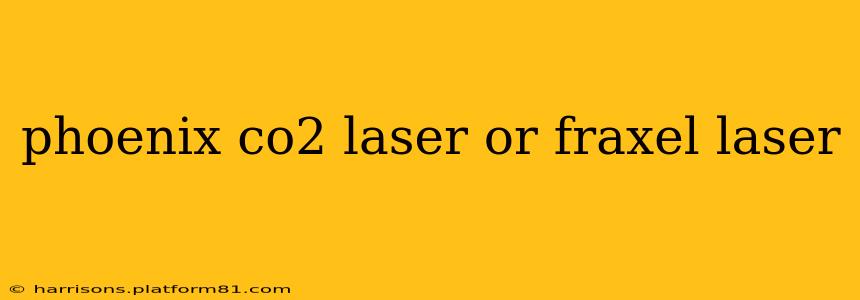Choosing between a Phoenix CO2 laser and a Fraxel laser for skin resurfacing can feel overwhelming. Both are powerful tools used to treat various skin concerns, but they differ significantly in their approach and outcomes. This comprehensive guide will delve into the nuances of each technology, helping you make an informed decision based on your specific needs and expectations. We'll explore their mechanisms, applications, recovery times, and potential side effects, addressing common questions to guide you towards the best treatment option.
What is a Phoenix CO2 Laser?
The Phoenix CO2 laser is an ablative laser, meaning it removes the outer layers of skin. It uses a high-energy beam of carbon dioxide to vaporize damaged skin cells, stimulating collagen production and revealing smoother, more youthful skin. The Phoenix CO2 laser is known for its ability to achieve dramatic results, tackling deep wrinkles, scars, and significant sun damage. Because it's ablative, it can treat a wider range of concerns than Fraxel, but also results in a more extensive recovery period.
What is a Fraxel Laser?
Unlike the Phoenix CO2 laser, Fraxel lasers are fractional resurfacing lasers. This means they only treat a fraction of the skin's surface at a time, leaving healthy tissue untouched. This approach minimizes downtime and accelerates healing. Fraxel lasers use micro-beams of energy to create tiny columns of treated skin, surrounded by healthy tissue. The healthy tissue helps the treated areas heal faster and reduces the risk of complications. Several different Fraxel laser types exist, offering varying depths of penetration and treatment intensities to target different skin concerns.
What are the Benefits of a Phoenix CO2 Laser?
- Dramatic Results: The Phoenix CO2 laser offers the most significant improvement in skin texture and tone compared to Fraxel. It's highly effective for deep wrinkles, acne scars, and sun damage.
- Comprehensive Treatment: Its ability to ablate skin tissue makes it suitable for a broader range of concerns than Fraxel.
What are the Benefits of a Fraxel Laser?
- Shorter Recovery Time: The fractional approach significantly reduces downtime compared to the Phoenix CO2 laser.
- Lower Risk of Complications: The preservation of healthy skin tissue minimizes the chance of scarring, infection, and other side effects.
- Targeted Treatment: Different Fraxel lasers can be customized to address specific skin concerns with varying depths of penetration.
What are the Side Effects of a Phoenix CO2 Laser?
- Longer Recovery Time: Expect significant swelling, redness, and crusting for several weeks.
- Higher Risk of Complications: Potential side effects include scarring, infection, and hyperpigmentation (darkening or lightening of the skin).
What are the Side Effects of a Fraxel Laser?
- Shorter Recovery Time: Expect mild redness, swelling, and some peeling, generally resolving within a few days to a week.
- Lower Risk of Complications: While complications are less frequent, there's still a possibility of minor scarring, infection, or changes in skin pigmentation.
Which Laser is Best for My Skin Type?
The ideal laser treatment depends on your individual skin type, concerns, and lifestyle. A consultation with a qualified dermatologist is crucial to determine the best option for your specific needs. Factors they'll consider include your skin tone, the severity of your skin damage, and your tolerance for downtime.
How Much Does Each Treatment Cost?
The cost of both Phoenix CO2 and Fraxel laser treatments varies depending on the location, the extent of the treatment area, and the number of sessions required. It's best to get personalized pricing quotes from your dermatologist.
How Long Does It Take to See Results?
Results from both treatments are gradual. With the Phoenix CO2 laser, significant improvement is visible after the initial healing period, with continued improvement over several months. Fraxel lasers provide more immediate, less dramatic results, with optimal outcomes appearing over several weeks.
What is the Difference in Recovery Time?
The Phoenix CO2 laser involves a significantly longer recovery time (several weeks) compared to Fraxel (a few days to a week).
Which Treatment is Less Invasive?
Fraxel laser treatment is considered less invasive due to its fractional approach and shorter recovery time.
In conclusion, both Phoenix CO2 and Fraxel lasers offer effective skin resurfacing solutions, but their approaches and outcomes differ significantly. A thorough consultation with a qualified dermatologist is paramount to determine which treatment best aligns with your individual needs and expectations. Remember to ask questions and fully understand the risks and benefits before making your decision.
